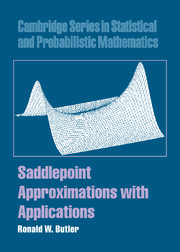Book contents
- Frontmatter
- Contents
- Preface
- 1 Fundamental approximations
- 2 Properties and derivations
- 3 Multivariate densities
- 4 Conditional densities and distribution functions
- 5 Exponential families and tilted distributions
- 6 Further exponential family examples and theory
- 7 Probability computation with p*
- 8 Probabilities with r*-type approximations
- 9 Nuisance parameters
- 10 Sequential saddlepoint applications
- 11 Applications to multivariate testing
- 12 Ratios and roots of estimating equations
- 13 First passage and time to event distributions
- 14 Bootstrapping in the transform domain
- 15 Bayesian applications
- 16 Nonnormal bases
- References
- Index
14 - Bootstrapping in the transform domain
Published online by Cambridge University Press: 25 February 2010
- Frontmatter
- Contents
- Preface
- 1 Fundamental approximations
- 2 Properties and derivations
- 3 Multivariate densities
- 4 Conditional densities and distribution functions
- 5 Exponential families and tilted distributions
- 6 Further exponential family examples and theory
- 7 Probability computation with p*
- 8 Probabilities with r*-type approximations
- 9 Nuisance parameters
- 10 Sequential saddlepoint applications
- 11 Applications to multivariate testing
- 12 Ratios and roots of estimating equations
- 13 First passage and time to event distributions
- 14 Bootstrapping in the transform domain
- 15 Bayesian applications
- 16 Nonnormal bases
- References
- Index
Summary
Sometimes nonparametric bootstrap inference can be performed by using a saddlepoint inversion to replace the resampling that is normally required. This chapter considers this general concept and pursues the extent to which the general procedure can implemented.
The main set of examples have been taken from Butler and Bronson (2002) and Bronson (2001). They involve bootstrap inference for first passage characteristics and time to event distributions in the semi-Markov processes discussed in chapter 13. Saddlepoint approximations of nonparametric bootstrap estimates are given for the mean and standard deviation of first passage and as well as for the density, survival, and hazard functions associated with the passage events. Thus saddlepoint approximations become estimates for these moments and functions and represent approximations to the estimates that would normally be provided were a large amount of resampling to be implemented with “single” bootstrap resampling. In performing these computations however, no resampling has been used to compute the estimates, only saddlepoint inversions. The saddlepoint estimates utilize data from the process through an empirical estimate T (s) of the unknown system transmittance matrix T (s). Empirical transmittance T (s) is used in place of T (s) when implementing the saddlepoint inversions.
In addition to bootstrap estimates, confidence intervals for the moments and confidence bands for the functions may be computed by using the double bootstrap. Often the resampling demands inherent in the double bootstrap place its implementation beyond the range of practical computing (Booth and Presnell, 1998).
- Type
- Chapter
- Information
- Saddlepoint Approximations with Applications , pp. 474 - 505Publisher: Cambridge University PressPrint publication year: 2007



